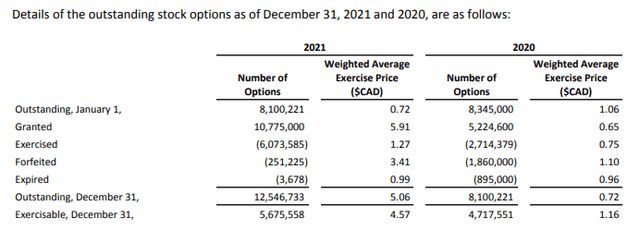bymuratdeniz/iStock via Getty Images
Introduction
It’s very nostalgic whenever we cover Bitfarms (NASDAQ:BITF). It rekindles our past trades where we successfully called the rally from $4 to $9 and sold call options to increase our returns. This series of trades lasted around 5–6 months, and we covered every step of the way to guide expectations and the respective actionable plans. It’s one of the series of trades we’re very proud of.
Fast-forward to today, BITF has undergone several major strategic overhauls. Firstly, BITF diverged from 100% renewable-powered to partially renewable-powered. Secondly, BITF adjusted its HODL policy to liquidate Bitcoin (BTC-USD) production reserves to expand and “enhance liquidity and to de-leverage and strengthen our balance sheet”. Regardless of whether we favor these policies, BITF managed to maintain its world-class mining operation (in terms of efficiency, Table i) and survive. On top of that, we have a BITF that is de-leveraged and leaner, which may or may not be a good thing.
In this article, we’re going to provide our price targets for BITF and discuss several key points that we think investors should consider before investing in BITF.
Table i. Total Mining Cost Per Bitcoin Comparison
| QR | BITF | CLSK | MARA |
| 2023Q1 | 26,600 | 33,276 | 32,100 |
| 2022Q4 | 34,200 | 30,500 | 44,400 |
| 2022Q3 | 25,900 | 35,627 | 91,200 |
| 2022Q2 | 27,155 | 37,600 | 81,683 |
| 2022Q1 | 34,340 | 42,800 | 31,700 |
| 2021Q4 | 35,000 | 46,400 | 32,240 |
| 2021Q3 | 24,000 | 57,506 | 95,850 |
| 2021Q2 | 33,025 | 119,000 | 21,000 |
| 2021Q1 | 59,137 | 74,500 |
Source: Author
Our View On BITF’s New HODL Policy
BITF’s previous Bitcoin policy is to retain 100% of self-mined Bitcoins. This allows BITF’s valuation to inflate together with Bitcoin’s price. This was one of the main drivers behind BITF’s rally in 2021. On the flip side, BITF had to cover expenses and funds through financing measures (equity offerings and debt). According to BITF:
Since January 2021, we have been funding operations and growth through various financing measures. We believe that selling a portion of our BTC holdings and daily production as a source of liquidity is the best and least expensive method in the current market environment.
By referring to Table 1, we can see that BITF’s liability and shares outstanding were increasing at a rapid rate when BITF is HODL-ing Bitcoins. After the HODL policy adjustment, total liability decreased drastically while shareholder dilution slowed down.
Table 1. BITF’s Historical Total Liability and Shares Outstanding
|
QR |
Total Liability |
Shares Outstanding |
|
2023Q1 |
59.3 |
240,262,000 |
|
2022Q4 |
87.5 |
224,200,000 |
|
2022Q3 |
114 |
215,711,000 |
|
2022Q2 |
137.95 |
206,339,320 |
|
2022Q1 |
179 |
201,626,602 |
|
2021Q4 |
120 |
194,805,893 |
|
2021Q3 |
40.6 |
174,445,684 |
|
2021Q2 |
30.3 |
162,083,352 |
|
2021Q1 |
22 |
145,016,864 |
Source: Author
On the surface, this looks good. BITF stated that this policy adjustment is strategic:
In consideration of extreme volatility in the markets, we have continued to take action to enhance liquidity and to de-leverage and strengthen our balance sheet.
But we think that BITF had done this out of necessity. Consider it this way, even if BITF is lean now, what will BITF’s expansion strategy be like? Is relying solely on selling self-mined Bitcoins sufficient to fund expansion, on top of operation and business costs? Let’s investigate.
The Inevitable
BITF’s May 2023 production is 459 Bitcoins, extrapolate for the quarter, it would be about 1,377, which is still lower than the peak in 2022Q3 (Table 2). At the current Bitcoin price ($25,500), BITF can liquidate 100% of the Bitcoin production for $35mil. BITF’s total business expense in 2023Q1 is $34mil. So it’s clear that self-mined Bitcoins aren’t sufficient to fund expansions.
Table 2: BITF’s Historical Bitcoin Production
| QR | Bitcoin Production |
| 2023Q2 | 1377 (estimated) |
| 2023Q1 | 1,297 |
| 2022Q4 | 1,434 |
| 2022Q3 | 1,515 |
Source: Author
You might argue at BITF’s cash expense is only $17mil, so BITF would have $18mil to fund expansion, right? We would counter by saying depreciation is an actual cost and BITF also must make loan repayments. Depreciation is an actual cost because mining machines have useful lives. Beyond the useful life, the mining machines will become unprofitable, and they’re also susceptible to wear and tear. Therefore, we can say that self-mined Bitcoins are insufficient to fund expansion.
This is very critical because BITF would be left with two choices: raise funds through equity or liability. In the past (Table 1), BITF resorted to both. By doing so, won’t BITF undo de-leveraging efforts and be back to square one (levered and diluted)?
Another supporting point we can make is if self-mined Bitcoins can fund expansion, why is it necessary to liquidate more than 90% of the Bitcoin reserves to pay back debt (Table 3)?
Therefore, we think being ‘de-leveraged’ a strategy is a necessity, not a choice. Let’s dive deeper.
Table 3. BITF’s Historical Bitcoin Reserves
| QR | BTC Reserves |
| 2023Q2 | 435 |
| 2023Q1 | 405 |
| 2022Q4 | 2,065 |
| 2022Q3 | 3,144 |
| 2022Q2 | 5,646 (April) |
Source: Author
Bitcoin Reserve Liquidation: A Necessity, Not Choice
Firstly, BITF couldn’t risk further major shareholder dilution to fund operations and expansions due to the risks of Nasdaq delisting. Towards the end of 2022Q4, BITF received a Nasdaq notification for failing to meet the exchange’s minimum bid price listing requirement because BITF traded below the minimum $1 per share for more than 30 days. Fortunately, Bitcoin’s timely recovery push BITF back above $1. Even though Bitcoin has traded higher than in January, BITF has been trading near and sometimes below $1. Any further increase in outstanding shares (shareholder dilution) could risk devaluating the share price.
We speculate that there might be forces supporting BITF’s $1 support level. This may explain why BITF has been lingering around $1. This could address some comments we read on Seeking Alpha about BITF lingering around $1, not rising or falling.
Secondly, BITF had to pay back the expiring loan to prevent bankruptcy. By referring to Figure 1, we can see that BITF has to repay $21mil of debt over the next 4 quarters. There are also other obligations totaling $19.5mil that have to be repaid.
Therefore, we think that BITF’s HODL policy is out of necessity, not by choice.
Figure 1. BITF’s Financial Commitments (BITF)
The Resulting Expansion Headwinds and Mining Difficulty
Given the constraints discussed above, it is no wonder BITF suffered a series of expansion setbacks and constant revision downwards. In 2021Q3, BITF had 2 EH/s mining capacity and guided investors that BITF would achieve 8 EH/s by the end of 2022. In 2022Q1, BITF revised the end-of-2022 target to 6 EH/s. But by 2022Q4, BITF failed to attain the 6 EH/s target and delayed it for another year. It seems that BITF will finally be attaining its 6 EH/s capacity by 2023Q3.
Unfortunately, the Bitcoin network hash rate (or the mining difficulty) grew by 93% annually. Due to the slow growth of BITF’s mining capacity and increasing mining difficulty, BITF has suffered a decline in Bitcoin production (Table 4). In the 2022Q4 and 2023Q1 quarterly reports, BITF attributed the decline in production to increasing mining difficulty:
13% increase in hash rate was offset by lower BTC prices and 20% increase in network difficulty”
However, we could also say that BITFs just couldn’t keep up with the competitors. Since the mining difficulty is the sum of the mining capacity of every Bitcoin miner, it implies that competitors are simply growing faster than BITF.
Table 4 shows the Bitcoin production and mining capacities of other Bitcoin mining companies. We can see that CleanSpark (CLSK), Riot Platforms (RIOT), and Marathon Digital Holdings (MARA) did not suffer a decline in production. Their mining capacities have also undergone a massive expansion. Only HIVE Blockchain (HIVE), which suffered from Ethereum’s pivot to Proof-of-Stake, trailed BITF.
Table 4: Bitcoin Production Comparison
| QR | BITF | CLSK | MARA | RIOT | HIVE |
| 2023Q1 | 1,297 | 1871 | 2195 | 2115 | |
| 2022Q4 | 1,434 | 1,531 | 1562 | 1689 | 792 |
| 2022Q3 | 1515 | 1,228 | 616 | 1042 | 787 |
| 2022Q2 | 1,257 | 964 | 707 | 1,395 | 1380* |
| 2022Q1 | 961 | 899 | 1,259 | 1405 | |
| 2021Q4 | 1,045 | 660 | 1,098 | 1355 | |
| 2021Q3 | 1,051 | 409 | 1,252 | 1292 | |
| 2021Q2 | 759 | 191 | 654 | 675 | |
| 2021Q1 | 598 | 144 | 192 | 491 |
Source: Author (*include Ethereum)
If BITF refuses to be left behind like HIVE, BITF needs to expand at a rapid rate. Unfortunately, BITF has run out of Bitcoin reserves to liquidate, while Bitcoin production is not sufficient to fund expansion. In addition, constraints on further shareholder dilution and liability will risk Nasdaq delisting. These headwinds are further reflected by a lack of expansion guidance beyond the 6 EH/s target.
Therefore, we are not optimistic about BITF’s growth prospects.
Valuation
BITF is currently trading at around the same market cap as CLSK, and HIVE. Furthermore, CLSK also uses a similar HODL strategy as BITF where CLSK liquidates most of the self-mined Bitcoin. However, CLSK is expected to expand to 16 EH/s by the end of 2023 compared to BITF’s 6 EH/s. Hence, it will be interesting to compare whether BITF’s world-class mining efficiency can outperform CLSK’s massive mining capacity in terms of potential upside.
Since both CLSK and BITF are trading below book value, we take them as undervalued. As for BITF’s potential upside, our model suggests that BITF has a 110% and 260% upside at a $69,000 and $100,000 Bitcoin respectively. Comparatively, CLSK has 200% and 470% upside if Bitcoin increases to $69,000 and $100,000 respectively.
This implies that BITF’s lower total mining cost per Bitcoin is advantageous during a crypto winter, but CLSK’s higher mining capacity is more advantageous in capturing the upsides during a Bitcoin bull market. That being said, our model suggests that BITF’s upside is greater than both MARA’s and RIOT’s.
Verdict
We think that BITF is undervalued and has a 110% to 260% potential upside. However, balance sheet constraints, mining difficulty, and slow capacity expansion are headwinds to BITF’s growth. More important, BITF could risk Nasdaq delisting if Bitcoin crashes or if BITF does not solve Bitcoin production issues soon enough.
Therefore, we suggest giving CLSK a look as CLSK also trading below book value, trading at a similar market cap as CLSK, and a much higher guided mining capacity.





![Bitcoin nearing wave three completion [Video]](https://techtelegraph.co.uk/wp-content/uploads/2025/02/BTC-neutral-object-1_Large-218x150.png)